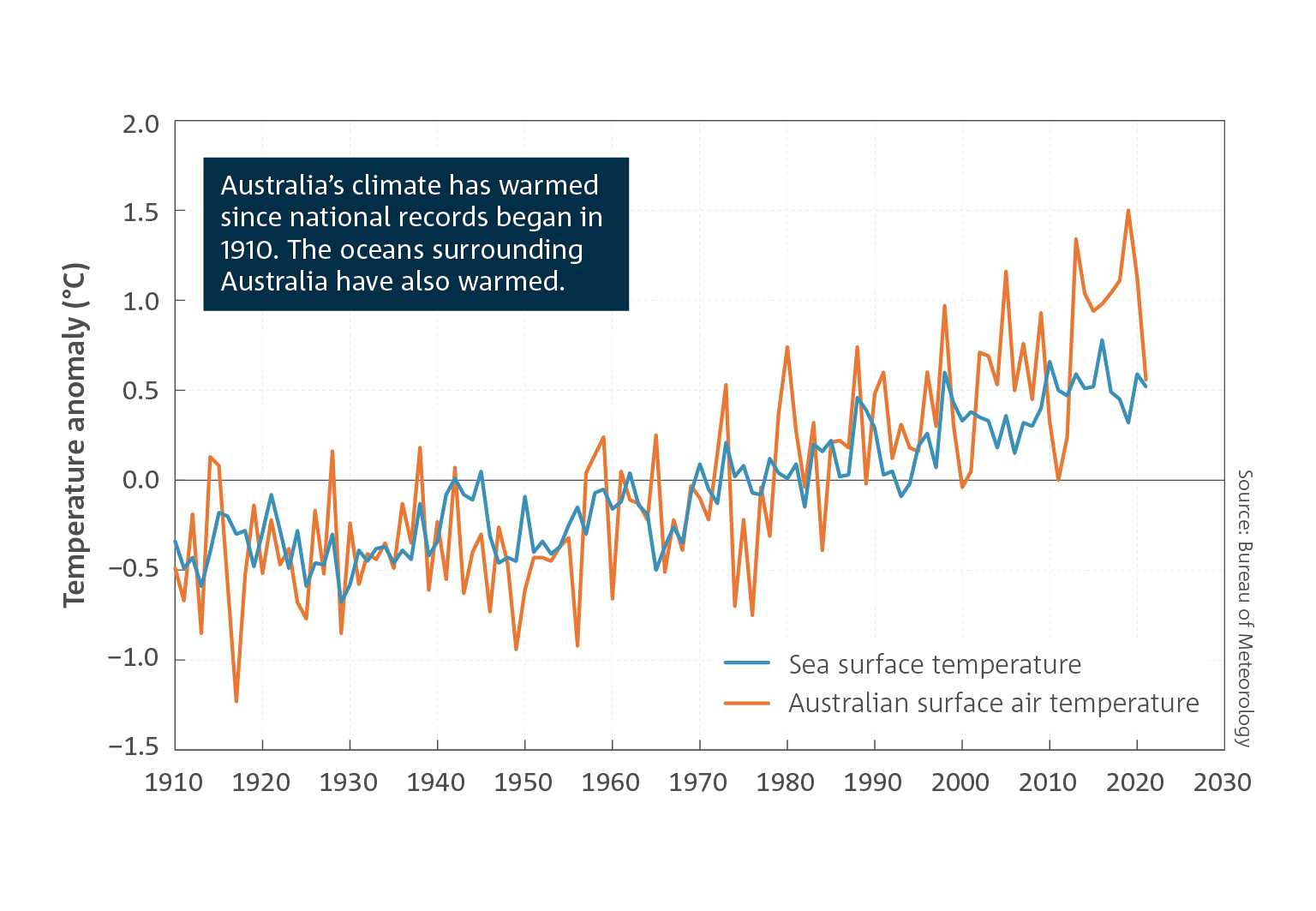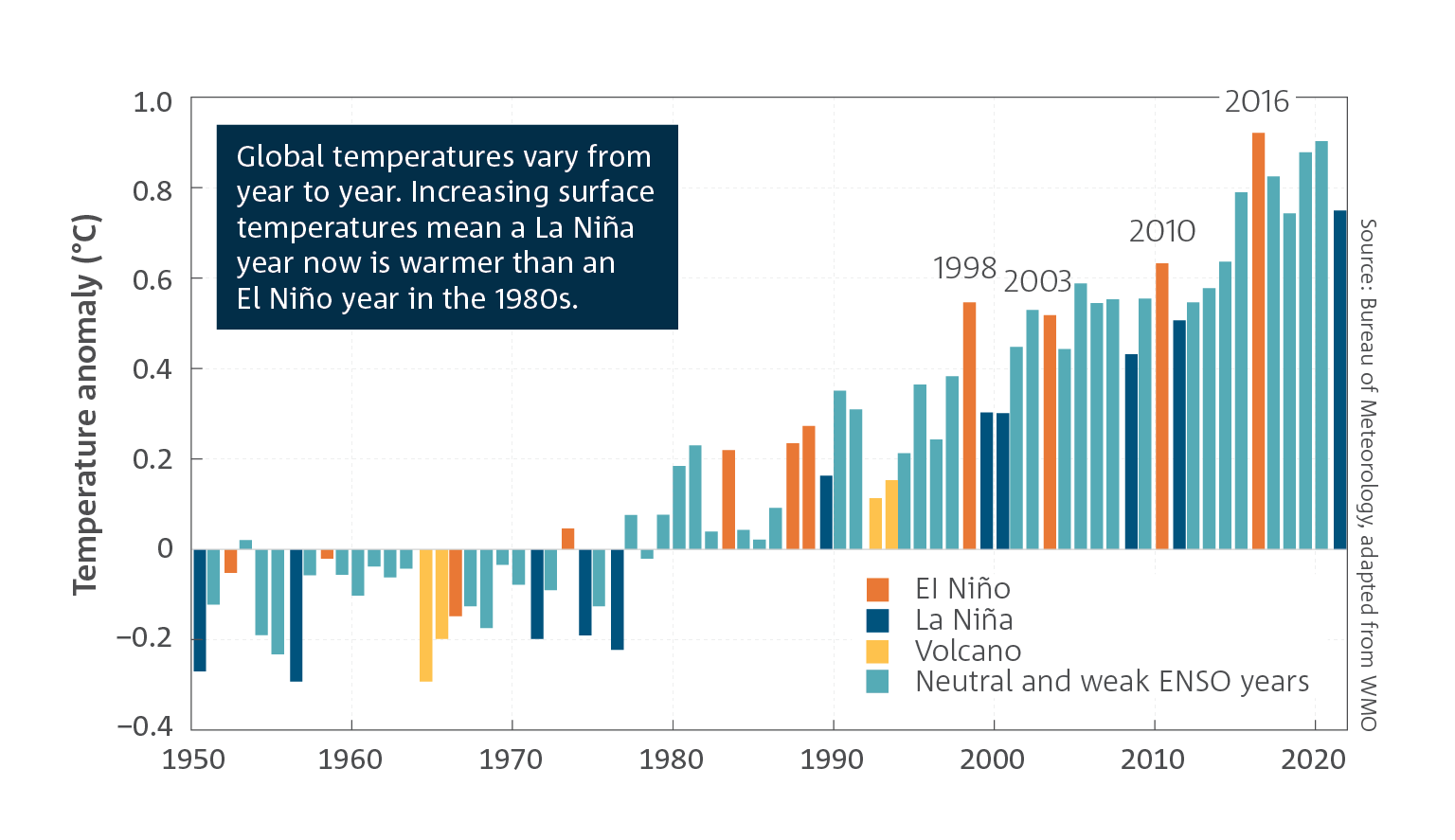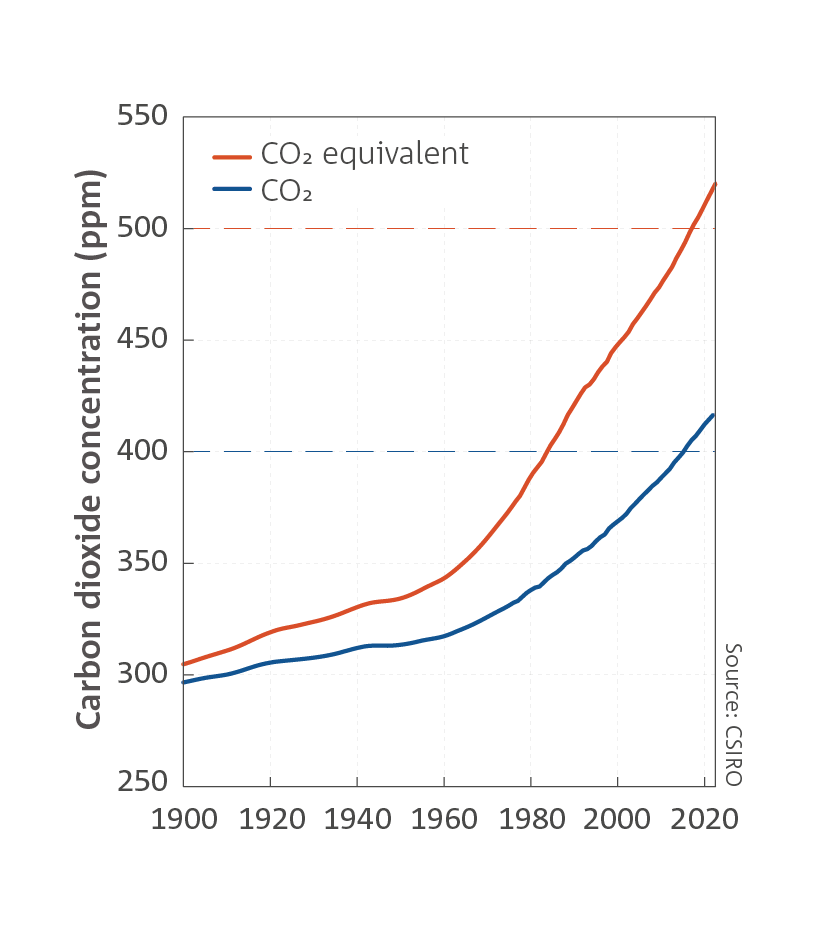This seventh biennial State of the Climate report draws on the latest national and international climate research, encompassing observations, analyses and future projections to describe year-to-year variability and longer-term changes in Australia's climate.
The report is a synthesis of the science informing our understanding of Australia’s climate. It includes new information since the last report in 2020, such as that published in the 2021 Sixth Assessment Report by the Intergovernmental Panel on Climate Change (IPCC).
The State of the Climate report is intended to inform a range of economic, environmental and social decision‑making by governments, industries and communities.
Observations, reconstructions of past climate and climate modelling continue to provide a consistent picture of ongoing, long‑term climate change interacting with underlying natural variability.
Associated changes in weather and climate extremes—such as extreme heat, heavy rainfall and coastal inundation, fire weather and drought—have a large impact on the health and wellbeing of our communities and ecosystems. These changes are happening at an increased pace—the past decade has seen record-breaking extremes leading to natural disasters that are exacerbated by anthropogenic (human-caused) climate change. These changes have a growing impact on the lives and livelihoods of all Australians.
Australia needs to plan for, and adapt to, the changing nature of climate risk now and in the decades ahead. The severity of impacts on Australians and our environment will depend on the speed at which global greenhouse gas emissions can be reduced.
Key points
Australia
- Australia’s climate has warmed by an average of 1.47 ± 0.24 °C since national records began in 1910.
- Sea surface temperatures have increased by an average of 1.05 °C since 1900. This has led to an increase in the frequency of extreme heat events over land and sea.
- There has been a decline of around 15 per cent in April to October rainfall in the southwest of Australia since 1970. Across the same region, May to July rainfall has seen the largest decrease, by around 19 per cent since 1970.
- In the south-east of Australia, there has been a decrease of around 10 per cent in April to October rainfall since the late 1990s.
- There has been a decrease in streamflow at most gauges across Australia since 1975.
- Rainfall and streamflow have increased across parts of northern Australia since the 1970s.
- There has been an increase in extreme fire weather, and a longer fire season, across large parts of the country since the 1950s.
- There has been a decrease in the number of tropical cyclones observed in the Australian region.
- Snow depth, snow cover and number of snow days have decreased in alpine regions since the late 1950s.
- Oceans around Australia are acidifying and have warmed by more than 1 °C since 1900, contributing to longer and more frequent marine heatwaves.
- Sea levels are rising around Australia, including more frequent extremes that are increasing the risk of inundation and damage to coastal infrastructure and communities.

Global
- Concentrations of all the major long-lived greenhouse gases in the atmosphere continue to increase, with global annual mean carbon dioxide (CO2) concentrations reaching 414.4 parts per million (ppm) in 2021 and the CO2 equivalent (CO2-e) of all greenhouse gases reaching 516 ppm. These are the highest levels on Earth in at least two million years.
- The decline in global fossil fuel emissions of CO2 in 2020 associated with the COVID-19 pandemic will have a negligible impact on climate change. Atmospheric CO2 concentrations continue to rise, and fossil fuel CO2 emissions, the principal driver of this growth, were back to near pre-pandemic levels in 2021.
- The rate of accumulation of methane (CH4) and nitrous oxide (N2O) (both greenhouse gases) in the atmosphere increased considerably during 2020 and 2021.
- Globally averaged air temperature at the Earth’s surface has warmed by over 1 °C since reliable records began in 1850. Each decade since 1980 has been warmer than the last, with 2011–20 being around 0.2 °C warmer than 2001–10.
- The world’s oceans, especially in the Southern Hemisphere, have taken up 91 per cent of the extra energy stored by the planet (as heat) as a result of enhanced greenhouse gas concentrations.
- More than half of all CO2 emissions from human activities are absorbed by land and ocean sinks, which act to slow the rate of increase in atmospheric CO2.
- Global mean sea levels have risen by around 25 cm since 1880 and continue to rise at an accelerating rate.

Future
In the coming decades, Australia will experience ongoing changes to its weather and climate. Australia is projected to experience:

- Continued increase in air temperatures, more heat extremes and fewer cold extremes.
- Continued decrease, on average, in cool season rainfall across many regions of southern and eastern Australia, which will likely lead to more time in drought, but with ongoing climate variability that will give rise to short-duration heavy-rainfall events at a range of timescales.
- Continued increase in the number of dangerous fire weather days and a longer fire season for southern and eastern Australia.
- Further sea level rise and continued warming and acidification of the oceans around Australia.
- Increased and longer-lasting marine heatwaves that will affect marine environments, such as kelp forests, and increase the likelihood of more frequent and severe bleaching events in coral reefs around Australia, including the Great Barrier Reef and Ningaloo Reef.
- Fewer tropical cyclones, but a greater proportion is projected to be of high intensity, with large variations from year to year.
- Reduced average snow depth in alpine regions, but with variations from year to year.
This seventh biennial State of the Climate report draws on the latest national and international climate research, encompassing observations, analyses and future projections to describe year-to-year variability and longer-term changes in Australia's climate.
The report is a synthesis of the science informing our understanding of Australia’s climate. It includes new information since the last report in 2020, such as that published in the 2021 Sixth Assessment Report by the Intergovernmental Panel on Climate Change (IPCC).
The State of the Climate report is intended to inform a range of economic, environmental and social decision‑making by governments, industries and communities.
Observations, reconstructions of past climate and climate modelling continue to provide a consistent picture of ongoing, long‑term climate change interacting with underlying natural variability.
Associated changes in weather and climate extremes—such as extreme heat, heavy rainfall and coastal inundation, fire weather and drought—have a large impact on the health and wellbeing of our communities and ecosystems. These changes are happening at an increased pace—the past decade has seen record-breaking extremes leading to natural disasters that are exacerbated by anthropogenic (human-caused) climate change. These changes have a growing impact on the lives and livelihoods of all Australians.
Australia needs to plan for, and adapt to, the changing nature of climate risk now and in the decades ahead. The severity of impacts on Australians and our environment will depend on the speed at which global greenhouse gas emissions can be reduced.
Key points
Australia
- Australia’s climate has warmed by an average of 1.47 ± 0.24 °C since national records began in 1910.
- Sea surface temperatures have increased by an average of 1.05 °C since 1900. This has led to an increase in the frequency of extreme heat events over land and sea.
- There has been a decline of around 15 per cent in April to October rainfall in the southwest of Australia since 1970. Across the same region, May to July rainfall has seen the largest decrease, by around 19 per cent since 1970.
- In the south-east of Australia, there has been a decrease of around 10 per cent in April to October rainfall since the late 1990s.
- There has been a decrease in streamflow at most gauges across Australia since 1975.
- Rainfall and streamflow have increased across parts of northern Australia since the 1970s.
- There has been an increase in extreme fire weather, and a longer fire season, across large parts of the country since the 1950s.
- There has been a decrease in the number of tropical cyclones observed in the Australian region.
- Snow depth, snow cover and number of snow days have decreased in alpine regions since the late 1950s.
- Oceans around Australia are acidifying and have warmed by more than 1 °C since 1900, contributing to longer and more frequent marine heatwaves.
- Sea levels are rising around Australia, including more frequent extremes that are increasing the risk of inundation and damage to coastal infrastructure and communities.
Australia’s climate has warmed since national records began in 1910. The oceans surrounding Australia have also warmed. Line chart of the temperature anomaly relative to the 1961 to 1990 average, in degrees Celsius, from 1910 to 2021, for temperatures over Australia and for sea surface temperatures in the Australian region. For a full description of this figure please contact: helpdesk.climate@bom.gov.au
Global
- Concentrations of all the major long-lived greenhouse gases in the atmosphere continue to increase, with global annual mean carbon dioxide (CO2) concentrations reaching 414.4 parts per million (ppm) in 2021 and the CO2 equivalent (CO2-e) of all greenhouse gases reaching 516 ppm. These are the highest levels on Earth in at least two million years.
- The decline in global fossil fuel emissions of CO2 in 2020 associated with the COVID-19 pandemic will have a negligible impact on climate change. Atmospheric CO2 concentrations continue to rise, and fossil fuel CO2 emissions, the principal driver of this growth, were back to near pre-pandemic levels in 2021.
- The rate of accumulation of methane (CH4) and nitrous oxide (N2O) (both greenhouse gases) in the atmosphere increased considerably during 2020 and 2021.
- Globally averaged air temperature at the Earth’s surface has warmed by over 1 °C since reliable records began in 1850. Each decade since 1980 has been warmer than the last, with 2011–20 being around 0.2 °C warmer than 2001–10.
- The world’s oceans, especially in the Southern Hemisphere, have taken up 91 per cent of the extra energy stored by the planet (as heat) as a result of enhanced greenhouse gas concentrations.
- More than half of all CO2 emissions from human activities are absorbed by land and ocean sinks, which act to slow the rate of increase in atmospheric CO2.
- Global mean sea levels have risen by around 25 cm since 1880 and continue to rise at an accelerating rate.
Future
In the coming decades, Australia will experience ongoing changes to its weather and climate. Australia is projected to experience:
- Continued increase in air temperatures, more heat extremes and fewer cold extremes.
- Continued decrease, on average, in cool season rainfall across many regions of southern and eastern Australia, which will likely lead to more time in drought, but with ongoing climate variability that will give rise to short-duration heavy-rainfall events at a range of timescales.
- Continued increase in the number of dangerous fire weather days and a longer fire season for southern and eastern Australia.
- Further sea level rise and continued warming and acidification of the oceans around Australia.
- Increased and longer-lasting marine heatwaves that will affect marine environments, such as kelp forests, and increase the likelihood of more frequent and severe bleaching events in coral reefs around Australia, including the Great Barrier Reef and Ningaloo Reef.
- Fewer tropical cyclones, but a greater proportion is projected to be of high intensity, with large variations from year to year.
- Reduced average snow depth in alpine regions, but with variations from year to year.
